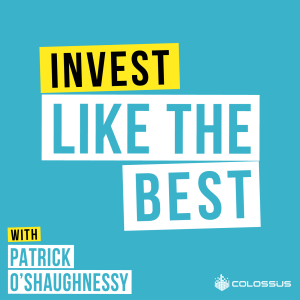
Invest Like the Best with Patrick O'Shaughnessy
Business:Investing
![Shark Tank with Thatcher Bell and Taylor Greene - [Invest Like the Best, EP.83]](https://megaphone.imgix.net/podcasts/1594747a-ccce-11ed-87bf-1b33902092c8/image/Greene__Bell.png?ixlib=rails-4.3.1&max-w=3000&max-h=3000&fit=crop&auto=format,compress)
Shark Tank with Thatcher Bell and Taylor Greene - [Invest Like the Best, EP.83]
 2018-04-17
2018-04-17
We’ve always found that even in public equities, you learn more once you have a live portfolio. One of the best ways to learn is to put some capital at risk.
To learn about the venture capital world, for example, I made an investment in a startup called Ladder, a platform business which connects coaches (fitness trainers to begin with) with consumers who need or want a coach to help them improve their fitness and their health. The idea is by making the entire coaching system more efficient, Ladder can provide consumers with a real person as a coach, but at a fraction of the cost, and provide coaches with both new customers and a much better way of managing their existing businesses. If you are interested in the businesses backstory, you can listen to episode #60 of the podcast to hear founder Brett Maloley’s story and his vision for Ladder.
We are now six months into the launch of the business, with thousands of users and coaches on the platform and run rate revenue past a million dollars. What I was most curious about at this stage, aside from building something useful, was the relationship between a startup and institutional venture capitalists, who are allocating capital from their funds into startups at various stages.
For this episode, I asked two VCs to sit down with me and Brett and treat the conversation as they would a normal pitch meeting, so that we, the audience, can get a peek into their world and the types of questions they ask.
The venture capitalists in question are Thatcher Bell, of CoVenture, and Taylor Greene, of Collaborative Fund. Both have experience evaluating new companies, but also have specifically spent time on companies like ladder, which follow the platform or marketplace model.
While we do cover a little bit of background on the company, I’ve edited most of that part out so we can talk about the business model itself. While I don’t spend much time talking in this episode, you will hear me asking Thatcher and Taylor some questions to better understand why they care or don’t care about certain aspects of a business.
Lastly, I love the data aspect of all this. The interaction between coaches and customers produces a wealth of data of different types, all of which is analyzed and used to improve each aspect of the process. To help gather more data—about onboarding, working with a coach, and tracking results—Brett and the Ladder team set up a little promo code for listeners, which can be accessed by going to joinladder.com and using the promo code ILTB2 as in Invest Like the Best 2.
The first voice that you’ll hear is Thatcher, and the next person asking questions is Taylor. I began by asking Thatcher to give us a bit of background on how he approaches young companies before diving in with questions of his own.
For more episodes go to InvestorFieldGuide.com/podcast.
Sign up for the book club, where you’ll get a full investor curriculum and then 3-4 suggestions every month at InvestorFieldGuide.com/bookclub.
Follow Patrick on Twitter at @patrick_oshag
Show Notes
3:12 – (First Question) – getting a flywheel business going
4:49 – Brett’s background and how that led to the formation of Ladder
7:58 – Breakdown of the product
9:29 – The sign-up process
10:29 – Key problem for each party of the ladder transaction
12:34 – Diving deeper into the problem of being a health coach
14:29 – How does Ladder differentiate itself from other apps that help people locate a trainer
17:01 – A deeper dive into the consumer using this product
20:28 – The accountability factor being the moat for Ladder
24:12 - How successful is the product right now in terms of recruiting new customers and trainers
28:38 – Their pre-launch interview and research process
31:49 – Going from hypothesis to product development
35:25 – What should founders think about when doing customer discovery, even after they have a product in the market
39:22 – Optimizing in the early stage of a business
43:24 – The defensive moat of a startup
46:20 – Their take on their ability to corner the coaches in this market
49:57 – Is there a side of the producer/consumer side of the equation that is more important.
55:42 – Getting and giving value to your supply, in this case the coaches
58:22 – How to view different phases of a business
1:00:43 – Growing the supply and demand so that neither side gets aggravated
1:02:28 – Market opportunity for Ladder
1:10:55 – Top 2 or 3 goals that Ladder has over the next 12-18 months
1:13:00 – Looking at Ladder, what are the strengths and weaknesses as a potential investment
1:20:40 – Pros and cons of a startup seeking institutional VC money
1:25:11 – Reviewing the pitch
Learn More
For more episodes go to InvestorFieldGuide.com/podcast.
Sign up for the book club, where you’ll get a full investor curriculum and then 3-4 suggestions every month at InvestorFieldGuide.com/bookclub
Follow Patrick on twitter at @patrick_oshag
More Episodes
Create your
podcast in
minutes
- Full-featured podcast site
- Unlimited storage and bandwidth
- Comprehensive podcast stats
- Distribute to Apple Podcasts, Spotify, and more
- Make money with your podcast
It is Free
- Privacy Policy
- Cookie Policy
- Terms of Use
- Consent Preferences
- Copyright © 2015-2024 Podbean.com



